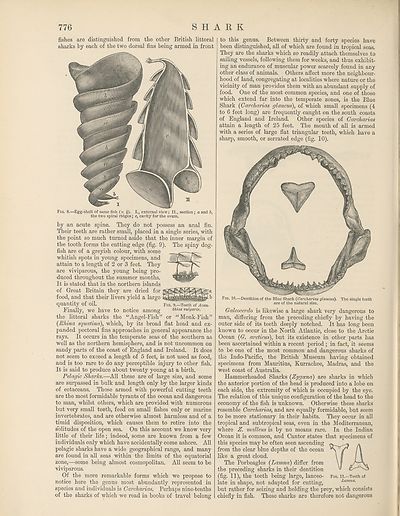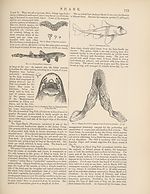Encyclopaedia Britannica > Volume 21, ROT-Siam
(786) Page 776
Download files
Complete book:
Individual page:
Thumbnail gallery: Grid view | List view

776
SHARK
fishes are distinguished from the other British littoral
sharks by each of the two dorsal fins being armed in front
Fig. 8.—Egg-shell of same fish (x 5). I., external view; II., section ; a and b,
the two spiral ridges; c, cavity for the ovum.
by an acute spine. They do not possess an anal fin.
Their teeth are rather small, placed in a single series, with
the point so much turned aside that the inner margin of
the tooth forms the cutting edge (fig. 9). The spiny dog¬
fish are of a greyish colour, with some
whitish spots in young specimens, and
attain to a length of 2 or 3 feet. They
are viviparous, the young being pro¬
duced throughout the summer months.
It is stated that in the northern islands
of Great Britain they are dried for
food, and that their livers yield a large
quantity of oil. Fig. 9.—Teeth of Acan-
Finally, we have to notice among thias vulrJaris-
the littoral sharks the “Angel-Fish” or “Monk-Fish”
(Rhina squatina), which, by its broad flat head and ex¬
panded pectoral fins approaches in general appearance the
rays. It occurs in the temperate seas of the southern as
well as the northern hemisphere, and is not uncommon on
sandy parts of the coast of England and Ireland. It does
not seem to exceed a length of 5 feet, is not used as food,
and is too rare to do any perceptible injury to other fish.
It is said to produce about twenty young at a birth.
Pelagic Sharks.—All these are of large size, and some
are surpassed in bulk and length only by the larger kinds
of cetaceans. Those armed with powerful cutting teeth
are the most formidable tyrants of the ocean and dangerous
to man, whilst others, which are provided with numerous
but very small teeth, feed on small fishes only or marine
invertebrates, and are otherwise almost harmless and of a
timid disposition, which causes them to retire into the
solitudes of the open sea. On this account we know very
little of their life; indeed, some are known from a few
individuals only which have accidentally come ashore. All
pelagic sharks have a wide geographical range, and many
are found in all seas within the limits of the equatorial
zone,—some being almost cosmopolitan. All seem to be
viviparous.
Of the more remarkable forms which we propose to
notice here the genus most abundantly represented in
species and individuals is Carcharias. Perhaps nine-tenths
of the sharks of which we read in books of travel belong
to this genus. Between thirty and forty species have
been distinguished, all of which are found in tropical seas.
They are the sharks which so readily attach themselves to
sailing vessels, following them for weeks, and thus exhibit¬
ing an endurance of muscular power scarcely found in any
other class of animals. Others affect more the neighbour¬
hood of land, congregating at localities where nature or the
vicinity of man provides them with an abundant supply of
food. One of the most common species, and one of those
which extend far into the temperate zones, is the Blue
Shark (Carcharias glaucus), of which small specimens (4
to 6 feet long) are frequently caught on the south coasts
of England and Ireland. Other species of Carcharias
attain a length of 25 feet. The mouth of all is armed
with a series of large flat triangular teeth, which have a
sharp, smooth, or serrated edge (fig. 10).
Fig. 10.—Dentition of the Blue Shark {Carcharias glaucus). The single teeth
are of the natural size.
Galeocerdo is likewise a large shark very dangerous to
man, differing from the preceding chiefly by having the
outer side of its teeth deeply notched. It has long been
known to occur in the North Atlantic, close to the Arctic
Ocean (G. arcticus), but its existence in other parts has
been ascertained within a recent period; in fact, it seems
to be one of the most common and dangerous sharks of
the Indo-Pacific, the British Museum having obtained
specimens from Mauritius, Kurrachee, Madras, and the
west coast of Australia.
Hammerheaded Sharks (Zygsena) are sharks in which
the anterior portion of the head is produced into a lobe on
each side, the extremity of which is occupied by the eye.
The relation of this unique configuration of the head to the
economy of the fish is unknown. Otherwise these sharks
resemble Carcharias, and are equally formidable, but seem
to be more stationary in their habits. They occur in all
tropical and subtropical seas, even in the Mediterranean,
where Z. malleus is by no means rare. In the Indian
Ocean it is common, and Cantor states that specimens of
this species may be often seen ascending
from the clear blue depths of the ocean
like a great cloud.
The Porbeagles (Lamna) differ from
the preceding sharks in their dentition
(fig. 11), the teeth being large, lanceo- fig. ii.—Teeth of
late in shape, not adapted for cutting, Lamna.
but rather for seizing and holding the prey, which consists
chiefly in fish. These sharks are therefore not dangerous
SHARK
fishes are distinguished from the other British littoral
sharks by each of the two dorsal fins being armed in front
Fig. 8.—Egg-shell of same fish (x 5). I., external view; II., section ; a and b,
the two spiral ridges; c, cavity for the ovum.
by an acute spine. They do not possess an anal fin.
Their teeth are rather small, placed in a single series, with
the point so much turned aside that the inner margin of
the tooth forms the cutting edge (fig. 9). The spiny dog¬
fish are of a greyish colour, with some
whitish spots in young specimens, and
attain to a length of 2 or 3 feet. They
are viviparous, the young being pro¬
duced throughout the summer months.
It is stated that in the northern islands
of Great Britain they are dried for
food, and that their livers yield a large
quantity of oil. Fig. 9.—Teeth of Acan-
Finally, we have to notice among thias vulrJaris-
the littoral sharks the “Angel-Fish” or “Monk-Fish”
(Rhina squatina), which, by its broad flat head and ex¬
panded pectoral fins approaches in general appearance the
rays. It occurs in the temperate seas of the southern as
well as the northern hemisphere, and is not uncommon on
sandy parts of the coast of England and Ireland. It does
not seem to exceed a length of 5 feet, is not used as food,
and is too rare to do any perceptible injury to other fish.
It is said to produce about twenty young at a birth.
Pelagic Sharks.—All these are of large size, and some
are surpassed in bulk and length only by the larger kinds
of cetaceans. Those armed with powerful cutting teeth
are the most formidable tyrants of the ocean and dangerous
to man, whilst others, which are provided with numerous
but very small teeth, feed on small fishes only or marine
invertebrates, and are otherwise almost harmless and of a
timid disposition, which causes them to retire into the
solitudes of the open sea. On this account we know very
little of their life; indeed, some are known from a few
individuals only which have accidentally come ashore. All
pelagic sharks have a wide geographical range, and many
are found in all seas within the limits of the equatorial
zone,—some being almost cosmopolitan. All seem to be
viviparous.
Of the more remarkable forms which we propose to
notice here the genus most abundantly represented in
species and individuals is Carcharias. Perhaps nine-tenths
of the sharks of which we read in books of travel belong
to this genus. Between thirty and forty species have
been distinguished, all of which are found in tropical seas.
They are the sharks which so readily attach themselves to
sailing vessels, following them for weeks, and thus exhibit¬
ing an endurance of muscular power scarcely found in any
other class of animals. Others affect more the neighbour¬
hood of land, congregating at localities where nature or the
vicinity of man provides them with an abundant supply of
food. One of the most common species, and one of those
which extend far into the temperate zones, is the Blue
Shark (Carcharias glaucus), of which small specimens (4
to 6 feet long) are frequently caught on the south coasts
of England and Ireland. Other species of Carcharias
attain a length of 25 feet. The mouth of all is armed
with a series of large flat triangular teeth, which have a
sharp, smooth, or serrated edge (fig. 10).
Fig. 10.—Dentition of the Blue Shark {Carcharias glaucus). The single teeth
are of the natural size.
Galeocerdo is likewise a large shark very dangerous to
man, differing from the preceding chiefly by having the
outer side of its teeth deeply notched. It has long been
known to occur in the North Atlantic, close to the Arctic
Ocean (G. arcticus), but its existence in other parts has
been ascertained within a recent period; in fact, it seems
to be one of the most common and dangerous sharks of
the Indo-Pacific, the British Museum having obtained
specimens from Mauritius, Kurrachee, Madras, and the
west coast of Australia.
Hammerheaded Sharks (Zygsena) are sharks in which
the anterior portion of the head is produced into a lobe on
each side, the extremity of which is occupied by the eye.
The relation of this unique configuration of the head to the
economy of the fish is unknown. Otherwise these sharks
resemble Carcharias, and are equally formidable, but seem
to be more stationary in their habits. They occur in all
tropical and subtropical seas, even in the Mediterranean,
where Z. malleus is by no means rare. In the Indian
Ocean it is common, and Cantor states that specimens of
this species may be often seen ascending
from the clear blue depths of the ocean
like a great cloud.
The Porbeagles (Lamna) differ from
the preceding sharks in their dentition
(fig. 11), the teeth being large, lanceo- fig. ii.—Teeth of
late in shape, not adapted for cutting, Lamna.
but rather for seizing and holding the prey, which consists
chiefly in fish. These sharks are therefore not dangerous
Set display mode to:
![]() Universal Viewer |
Universal Viewer | ![]() Mirador |
Large image | Transcription
Mirador |
Large image | Transcription
Images and transcriptions on this page, including medium image downloads, may be used under the Creative Commons Attribution 4.0 International Licence unless otherwise stated. ![]()
| Encyclopaedia Britannica > Encyclopaedia Britannica > Volume 21, ROT-Siam > (786) Page 776 |
|---|
| Permanent URL | https://digital.nls.uk/193637497 |
|---|
| Attribution and copyright: |
|
|---|---|
| Shelfmark | EB.17 |
|---|---|
| Description | Ten editions of 'Encyclopaedia Britannica', issued from 1768-1903, in 231 volumes. Originally issued in 100 weekly parts (3 volumes) between 1768 and 1771 by publishers: Colin Macfarquhar and Andrew Bell (Edinburgh); editor: William Smellie: engraver: Andrew Bell. Expanded editions in the 19th century featured more volumes and contributions from leading experts in their fields. Managed and published in Edinburgh up to the 9th edition (25 volumes, from 1875-1889); the 10th edition (1902-1903) re-issued the 9th edition, with 11 supplementary volumes. |
|---|---|
| Additional NLS resources: |
|

